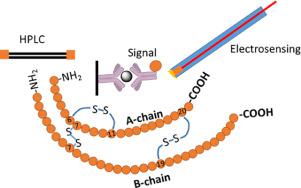Sensors and Actuators Reports ( IF 6.5 ) Pub Date : 2021-01-27 , DOI: 10.1016/j.snr.2021.100028 Albert-Donald Luong , Ipsita Roy , Bansi D. Malhotra , John H.T. Luong

|
Human insulin regulates carbohydrate metabolism to maintain the blood glucose level and this peptide hormone has been considered an important biomarker in diabetic management. Several fast-acting and long-acting insulin analogs have also emerged to improve insulin dose regimes for chronic diabetic patients. The administration of insulin is currently based on some glucose-insulin models; however, simultaneous measurement of glucose and insulin enables better glucose control and circumvents abnormal levels of blood insulin. Reliable quantification of glucose is well served by glucose meters, which have become less invasive and more powerful, and even non-invasive devices for continuous monitoring of glucose have emerged. However, the measurement of insulin and its analogs is more difficult and complicated due to their large size (> MW 5.8 kDa) and picomolar levels in the blood as well as the presence of endogenous interfering molecules. In clinical and hospital settings, insulin detection is performed by fully automated immunoassay platforms with high throughput and reliability. Chromatographic techniques equipped with tandem mass spectrometry perform the separation of insulin from its analogs. Albeit insulin can be electrochemically oxidized, electroanalysis still lacks detection sensitivity and selectivity without sample pre-treatment. Biosensing based on aptamers and molecular imprinted polymers (MIP) shows great promise to overcome these two key drawbacks. Future developments will focus on robust antibodies, aptamers, and insulin selective biorecognition elements with high selectivity, stability, and capacity. Such robust aptamers might open the possibility for the development of Point-of-Care (POC) devices to measure ultra-low levels of insulin in blood with high selectivity and reliability.
中文翻译:

胰岛素分析和生物传感平台:综述
人胰岛素调节糖代谢以维持血糖水平,该肽激素被认为是糖尿病治疗中的重要生物标志物。还出现了几种速效和长效胰岛素类似物,以改善慢性糖尿病患者的胰岛素剂量方案。目前,胰岛素的给药是基于某些葡萄糖-胰岛素模型的。但是,同时测量葡萄糖和胰岛素可以更好地控制血糖,并规避血液胰岛素的异常水平。血糖仪可对葡萄糖进行可靠的定量,血糖仪的侵入性越来越小,功能越来越强大,甚至出现了用于持续监测葡萄糖的非侵入性设备。但是,由于胰岛素及其类似物的尺寸较大(> MW 5。8 kDa)和血液中的皮摩尔水平,以及内源性干扰分子的存在。在临床和医院环境中,胰岛素检测是通过具有高通量和可靠性的全自动免疫测定平台进行的。配备串联质谱的色谱技术可将胰岛素从其类似物中分离出来。尽管胰岛素可以被电化学氧化,但是电分析仍然缺乏检测灵敏度和选择性,而无需样品预处理。基于适体和分子印迹聚合物(MIP)的生物传感显示出克服这两个关键缺陷的巨大希望。未来的发展将集中在具有高选择性,稳定性和容量的强大抗体,适体和胰岛素选择性生物识别元件上。











































 京公网安备 11010802027423号
京公网安备 11010802027423号